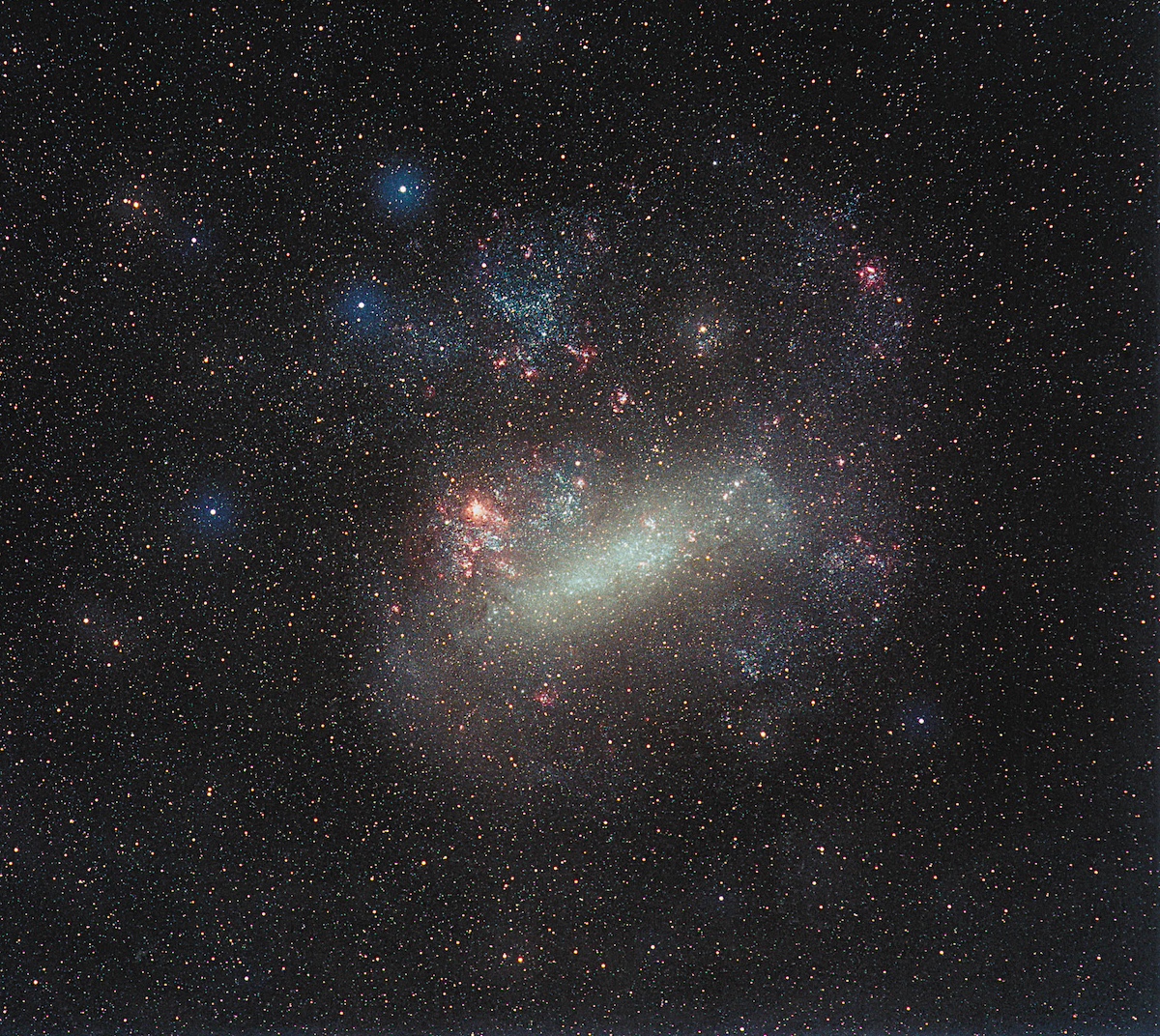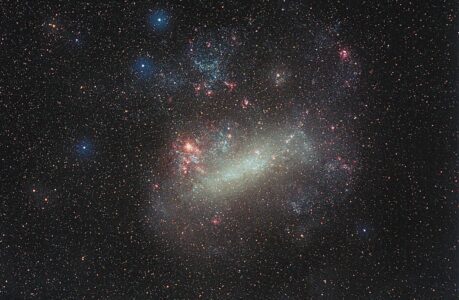Unveil the mysteries of the Large Magellanic Cloud, a galactic neighbor that astounds astronomers and stargazers alike. Learn about its mesmerizing features, intriguing history, and its crucial role in our understanding of the universe.
Introduction
In the vast expanse of our cosmos, there exists a mesmerizing celestial spectacle—a cosmic neighbor known as the Large Magellanic Cloud (LMC). This celestial marvel, situated a mere 160,000 light-years away from Earth, has captured the imagination of astronomers and stargazers for centuries. With its alluring beauty and enigmatic features, the LMC stands as an astronomical gem that beckons us to explore its secrets.
A Galactic Neighbor: What is the Large Magellanic Cloud?
The Large Magellanic Cloud is a dwarf irregular galaxy that orbits our very own Milky Way. It’s one of the most prominent members of the Local Group, a cluster of galaxies that includes our Milky Way, the Andromeda Galaxy, and around 54 other smaller galaxies. The LMC is the third-largest galaxy in the Local Group, trailing only behind the Milky Way and the Andromeda Galaxy.
Unveiling the Cosmic Beauty
The LMC spans an area of approximately 14,000 light-years and shines brilliantly in the southern hemisphere’s night sky. Its proximity to Earth makes it one of the most prominent and easily observable galaxies in the night sky, especially from the Southern Hemisphere. To truly appreciate its splendor, one can observe it with the naked eye or through a pair of binoculars on a clear, dark night.
Take a virtual tour of the Large Magellanic Cloud
A Cosmic Menagerie: What Makes the LMC Special?
The Large Magellanic Cloud isn’t just any ordinary galaxy; it’s a treasure trove of celestial wonders and cosmic curiosities. Here are some of the most remarkable features that set the LMC apart:
1. Stellar Fireworks Galore
One of the most striking features of the LMC is its propensity for stellar fireworks. It is a hotbed of stellar birth and death. Within its boundaries, you’ll find a myriad of nebulae, supernova remnants, and star clusters. These cosmic phenomena paint the LMC in vivid colors, with nebulae like the Tarantula Nebula showcasing vibrant pinks and purples.
Explore the Tarantula Nebula
2. Bridge to the Milky Way
The LMC and its smaller sibling, the Small Magellanic Cloud (SMC), are connected to the Milky Way by a tenuous bridge of gas and dust. This connection, known as the Magellanic Bridge, has been a topic of great interest to astronomers. It plays a crucial role in the exchange of material between the galaxies and has contributed to the evolution of our own Milky Way.
3. Supernova 1987A: A Stellar Spectacle
In 1987, astronomers witnessed a momentous event in the LMC—a supernova explosion known as SN 1987A. This event, which marked the explosive death of a massive star, provided a unique opportunity to study the life cycles of stars in unprecedented detail. It remains one of the most studied supernovae in history.
Learn more about SN 1987A
The Rich History of LMC Exploration
The history of studying the LMC dates back to ancient times when Indigenous Australian cultures and South American civilizations observed its presence in the night sky. However, it wasn’t until the age of modern astronomy that the LMC’s true nature began to unfold.
Early Observations
European astronomers, Ferdinand Magellan and his crew, were among the first to document the LMC during their circumnavigation of the Earth in the early 16th century. The LMC’s name pays homage to Magellan, who played a pivotal role in introducing this enigmatic galaxy to the Western world.
Pioneering Discoveries
In the 18th century, astronomers like Nicolas-Louis de Lacaille made significant contributions to our understanding of the LMC. Lacaille cataloged numerous stars and nebulae within the LMC, laying the foundation for future astronomical research.
Modern-Day Exploration
The advent of telescopes and space-based observatories, such as the Hubble Space Telescope, revolutionized our ability to study the LMC in detail. These modern tools have allowed astronomers to peer deep into the galaxy, unraveling its mysteries one discovery at a time.
Explore the Hubble Space Telescope’s LMC images
The LMC’s Role in Our Cosmic Odyssey
The Large Magellanic Cloud isn’t just a cosmic spectacle; it plays a vital role in our ongoing quest to understand the universe. Let’s delve into how this enigmatic galaxy contributes to our cosmic odyssey.
Cosmological Significance
One of the LMC’s most profound contributions is its role in measuring the Hubble Constant, a fundamental parameter that quantifies the universe’s expansion rate. By studying the LMC and other galaxies, astronomers can refine their calculations and better understand the age and fate of our universe.
Learn more about the Hubble Constant
Stellar Laboratories
The LMC’s unique environment, replete with diverse stellar populations, provides astronomers with invaluable stellar laboratories. Here, they can study different stages of stellar evolution, from the birth of stars within dense nebulae to the explosive deaths of massive stars in supernova events.
A Window to Galactic Evolution
The LMC’s interactions with the Milky Way offer a glimpse into the complex dance of galaxies in our universe. By studying these interactions, astronomers gain insights into how galaxies form, evolve, and influence each other’s destinies over cosmic timescales.
The Future of LMC Exploration
As technology advances and our understanding of the universe deepens, the future of LMC exploration holds boundless possibilities. Here are some exciting prospects on the horizon:
Advanced Telescopes
Upcoming space-based observatories, such as the James Webb Space Telescope (JWST), promise to unveil even more of the LMC’s secrets. With its enhanced capabilities, the JWST will provide unprecedented views of distant galaxies, shedding new light on the LMC’s enigmatic features.
Learn about the James Webb Space Telescope
Citizen Science Initiatives
Astronomy enthusiasts and citizen scientists worldwide can contribute to LMC research through projects like the Zooniverse. By classifying and analyzing data from space telescopes, anyone can participate in the exploration of this cosmic neighbor.
Join the Zooniverse
International Collaborations
Astronomical observatories across the globe are increasingly collaborating on LMC research. These partnerships facilitate the sharing of data, resources, and expertise, accelerating our understanding of this captivating galaxy.
Conclusion
The Large Magellanic Cloud, a celestial marvel in our cosmic neighborhood, continues to captivate astronomers and stargazers alike. With its vibrant nebulae, stellar fireworks, and crucial contributions to our understanding of the universe, the LMC stands as a testament to the beauty and mysteries of the cosmos. As we look toward the future of LMC exploration, we can only imagine the discoveries that await us in this enigmatic corner of the universe.
Whether you’re an aspiring astronomer or simply a lover of the night sky, the LMC beckons you to gaze upon its celestial wonders and join in the grand cosmic adventure of unraveling its secrets.
Explore More of the Universe:

